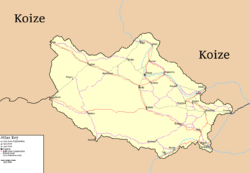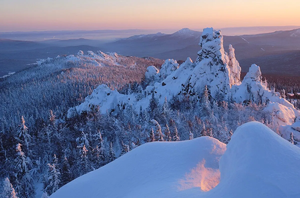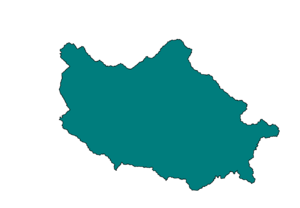Difference between revisions of "Archive:Hodek"
Pittman789 (talk | contribs) |
|||
| Line 138: | Line 138: | ||
==Climate== | ==Climate== | ||
[[File:Climate Map.png|thumb|right|Hodek is entirely within the Köppen climate classification Dfc]] Hodek is entirely classified as being within the boreal subarctic climate classification. Much of the country sees | [[File:Climate Map.png|thumb|right|Hodek is entirely within the Köppen climate classification Dfc]] Hodek is entirely classified as being within the boreal subarctic climate classification. Much of the country sees 6 to 7 months of the year being in subzero temperatures, with summers being mild seeing warmest-month average highs in the high teens to low 20s in most areas, with mid-20s average highs not being unknown. Permafrost can sometimes persist throughout the entire year depending on region, latitude, and elevation. There have been recorded instances of snow in Hodek's capital, Tékely, not thawing until mid to late June as a result of cold snaps, though rainfall levels in Hodek rarely exceed 30 inches in most places. The coldest temperature recorded in Hodek was -59.2 C (-74.56 F). This temperature was achieved in Ubli, a village within the Tambuk plains. | ||
==Demographics== | ==Demographics== | ||
Revision as of 07:04, 7 September 2020
| Republic of Hodek Fegedneny Hodekluya Fegedneny Hodekluya Fegedneny Hodekluya |
||||
|---|---|---|---|---|
|
||||
| Anthem: Salsna Nankuya (Salsna Nankuya) The Mountain of the United |
||||
| Location |  Map of Hodek including local major infrastructures |
|||
| Capital and largest city | Tékely | |||
| Official languages | Hodeki Koizan |
|||
| Recognised national languages | Terminian Balak |
|||
| Recognised regional languages | TBD | |||
| Ethnic groups | ||||
| Demonym | Hodeki | |||
| Government | Unitary dominant-party presidential constitutional republic | |||
| - | Chairman of the Independence Party | Babfyed Sóvtamuk | ||
| - | President | Kyígfyed Balnekk | ||
| - | Prime Minister | Kúkliffyed Tórme | ||
| - | Minister of the Interior | Terdegcag Ólai | ||
| - | Chairman of the Hodeki Armed Forces | Mafsfyed Fíkyhand | ||
| Legislature | Parliament | |||
| - | Upper house | Fegedneny | ||
| - | Lower house | Ílgelneny | ||
| Area | ||||
| - | Total | 775,111 km2 481,631 sq mi |
||
| Population | ||||
| - | 2018 census | 1317688 | ||
| - | Density | 1.7/km2 2.735/sq mi |
||
| GDP (nominal) | estimate | |||
| - | Total | $7.1 Billion USD | ||
| - | Per capita | $5,430 USD | ||
| Gini | 36.9 medium |
|||
| HDI | 0.792 high |
|||
| Date format | dd/mm/yyyy | |||
| Drives on the | right | |||
| ISO 3166 code | HDK | |||
| Internet TLD | .hk | |||
Hodek, known officially as the Republic of Hodek (Hodeki: Fegedneny Hodekluya, Fegedneny Hodekluya, tr. Fegedneny Hodekluya, [feɢedneɲ‿ɦodeqɬujɒ]), is a landlocked country located within Central Miraria and north of the Miralayas. It is partially bordered to the East along the Belk and Cakar rivers. It is bordered with the nations of Koize and TBD(s?). It is 4th least densely populated nation upon Sahar, with the lesser densely populated nations as Achiyitqana, Translira, and Nolcik being less densely populated. Its official languages of Hodeki and Koizan are of Ryamaian and Mahavi descent respectively, as Hodeki is itself a language isolate belonging to the greater Ryamaian language family making it related to the Vaniuan languages, though it is closely related to the Sirchak languages within Ensia and Suenia. For centuries prior to its independence in 1828, Hodek saw no true national identity and was a series of various tribal entities belonging as tributaries or vassal clans to the Mahavi Khanates following the expansion of the Sunrise Horde.
During the 1800s, Hodek's population saw an upswing as a result of migration following the discovery of gold along the upper Cakar river tributaries. This spur in migration during a period of instability between various regions along the Parshita brought many peoples to Hodek, further improving its technological and economic base. Within 20 to 30 years, Hodek's economy had improved, but civil war led to Kuulist collectivization efforts resulting in stagnation of the economy, as well as an exodus of many educated individuals as a result of purges within the government and military. Despite surviving several Koizan military incursions, eventually Hodek's Kuulist government collapsed in 1954 after two years of protests and dissent. For most of the following period, Hodek has yet to recover from the Kuulist collectivization efforts, and has only slowly returned to being a recognizable 2nd World nation as a result of foreign assistance and efforts to bring in educated individuals to reverse the brain drain from 70 years earlier. Hodek today performs favorably in regards to civil liberties, press freedom, democratic governance, and its respect of equal rights for the Vodholk minority groups within the country.
Etymology
The source of the name Hodek is of unknown origin with several suggestions put forth to explain the source of the name. The most popular belief amongst linguists is the compound of the words from Proto-Degic *kod "fine/quality" and *eki meaning "to wash/that which is washed". Other theories is from the formations of *hu- "By/Near" and *dek meaning "together, connected" referring to the congregation of the Cakar and Belk rivers.
History
Prior to the expansion of the Sunrise Horde, much isn't known about Hodek in written sources prior to the arrival of Mahavic groups. What is known is through archaeology and guess made by various scientists regarding the genetics of Hodeki and other local peoples. The first known settlements were by the Síky cultures around the year 600, as were found that workshops involving the making of bronze still existed, indicating a slower adaptation to the usage of iron, likely owing to its isolated location. Copper, however, was the primary metal of choice by these peoples for tool-making prior to the advent of iron working by 800s. By the 900s, the use of iron saw a boom and many tools and art pieces made of iron have been found at sites along the Belk and Cakar river valleys. The first known reference to the Degic peoples themselves was around the 1420s in administrative notes from the Green Khanate referring to the Degic peoples within the Belk valley and along the width of the Cakar river.
1550s–1828: Khanate Tributaries
1828–1920: First Republic of Hodek
1918–1924: Hodeki Civil War
See also: Hodeki Civil War
During the later years of the Hodeki republic, factions spawned from various ethno-nationalist parties and workers unions, creating an atmosphere of tension as the economic situation in Hodek declined due to a regional recession. The most prominent workers union was led by a council known as the Ílgel-Hodekly, which had some 70,000 members at the time. The members holding leadership positions within this faction were Arrhody Bonfyed, Amb Belycag, Lévis Lévisfyed, and Kyuggengy Minnfyed. The IH as they were known, led some of the largest strikes during the lead-up to the civil war, having pressured the cities and their respective administrative areas into several land reforms, officially claiming to support workers rights. In contrast, one of the largest organizations with ties to the republican government was the Balkist faction known as the Fágmuk KésTékyiky, whose members were inspired by Yurik Balkas's works. The largest supporters of this faction were members of the republican military staff, as well as various business and social leaders in more rural areas. The Balkist faction saw an official membership figure of around 80,000 across the country. In addition to these factions, there were also the Kyánduks, local and territorial factions who opposed both the Balkists and the Unions.
The situation in the late 1910s saw increasing hostilities between migrant communities and Hodeki natives. In addition, new philosophical ideas and the influx of new technologies to the country had changed the country significantly over the past 50 years. The resulting political tensions made maintaining order difficult as extremists from all sides took part in local conflicts with one another. Most notable was during a strike action where some 20,000 were participating in protests within the capital of Tekely, were openly attacked by members of the FKT on July 21, 1918. 82 strikemakers had perished in the fighting while 68 members of the FKT and local law enforcement were killed in the ensuing fighting. For three weeks after this incident, riots had taken place throughout Tekely, leading to early elections being called for by then President Kyakség Midfyed. The violence caused outroar throughout the nation, leading to increased tensions over the following months. During February of 1919, a revolt of an entire battalion in the armory of Medly is considered to be the first instance of the civil war's start.
The first battle of the civil war took place on the road of Medly-Tekely which saw militias of the IH and members of the Hodeki National Army engage in fierce fighting. The battle was a victory for the union movement, bringing their prominence in the republican scene to before impossible levels, as the Ílgel-Umbdeg refused to negotiate on matters of a merger. While both factions did not merge, they did agree to an armistice in the hopes of being able to defeat the FKT and Nationalist forces. The FKT successfully defended Tekely in the summer of 1919, effectively prolonging the war as the IH and IU began actions against the FKT in the regions around Bátles, Síngy, and Endseg. The fighting became intense throughout the north of the country that Koize itself took interest and intervened, occupying territory along the Cakar river. They had attempted to occupy the core cities of Síngy and Endseg, however, IH militias removed the Koizan forces from them, protecting much of the region. Koize's presence within the civil war was still felt as various military sorties occurred in disputed zones.
As the war continued, the IH slowly became a party with a singular leader as Arrhody managed to successfully lead militias in battle and was a significant factor in the organization of the militias and their associated forces. As a result, he had gained himself an almost cult-like following within the IH and after the murder of Lévisfyed, much of the leadership opposed to him fled the country as suspicion of Arrhody's involvement spread. Further infighting began as conflict with the IU's militias broke out in Yenink with the IH blaming the IU for not playing a large enough role in the fighting and the IU blaming the IH for not supplying their militias with the necessary material to fight the FKT and the Nationalists. The armistice that had once existed between the two broke down and fighting in the Yertmik mountains continued for another year.
With the limited campaign time permitted by the seasonal differences, summer saw most of the fighting throughout the years Hodek was in conflict, while winter saw consolidation of their positions and re-organization attempts in preparation for the next year. Winter did see several instances of conflict with the FKT and the IH, such as in 1922 with the skirmishes near Hodku that left nearly 3,000 casualties on both sides of the fighting. Entire villages during the war were destroyed and the city of Lizfód along with its population of 25,000 was burned to the ground entirely during the intense fighting. The city was entirely destroyed with only the scarred remains of stone strutures remaining, many of its population having fled or perished. This action led to the FKT losing significant popularity as calls for change within their own ranks made their position untenable as desertion reached all-time highs. Eventually, a rumor had spread throughout the FKT that Mikyedvite Túgfyed, then joint-leader of the nationalists and balkists, was intending to make a deal with the Koizans. This led to the complete collapse of the FKT's already diminished morale, causing mass desertion and overall collapse of their war gains over the past two years. With the FKT and the Nationalists dissolved, all that opposed Arrhody was the IU and the Kyánduks which, already in a weakened position, surrendered piece by piece that same year with some strongholds remaining until late 1925. The civil war had effectively come to an end by October 1925.
1923–1954: Kuulist People's Territory
1954–present: Second Republic of Hodek
Following the peaceful transition of the government from the Kuulist to a more democratic state, elections were held in late 1954, resulting in Víngy Méghod being elected as the first Chairman of the Independence Party. Privatization of many elements of Hodek's state run economy had occurred, most notably the collective communes involving mining and reindeer herding. As a result, many small businesses propped up but due to the pre-existing income disparity, many of those who now owned these businesses conveniently members of the Hodeki Kuulist Party before its dissolution in the peaceful transition. As a result, much of the leadership and business practices in Hodek's economy still held a lack of efficiency despite the privatization. Efforts were introduced under Víngy Méghod's chairmanship to guide Hodek towards a more democratic system, however, he was not capable of reducing the economic disparity nor the brain-drain that had plagued the nation.
By the 80s and 90s, Hodek saw a series of foreign investors bring their businesses to Hodek during Beketfyed Selneg's chairmanship, when several restrictions on foreign investments were lifted, allowing companies such as Pearl to acquire various mines that had since gone out of business at rates that would later receive controversy regarding the sales. The Qonklese Pearl company purchased nearly 50,000 square kilometers of area for their mining efforts for a total of $40 Million USD in 1983, severely under cutting the value of the area. As a result of the corruption scandal, Beketfyed was forced to begin early elections where he'd lost to Micfyed Síngy's 52% of the vote in May of 1985. While some had expected Micfyed to reverse the sale of the land, Micfyed decided to renegotiate the terms of sale requiring the use of Hodeki workers as well as a roughly $2 Million USD donation towards public engineering schools in Hodek. The Pearl Company, however, refused but agreed to donate a 1% portion of resulting sales of Hodeki minerals to the Hodeki education system, solving most of the crisis regarding the legality of the sale.
Since 2002, Hodek has been led by Chairman Físelceg Mas, being the first female leader of Hodek, and also the first Hodeki to be of partial Mahavi descent. Físelceg has met opposition within the Fegedneny regarding the legal limitations of the military in 2014, where four citizens were killed during a dispute amongst patrons at a hotel in Noly. Despite calls for her to resign and call early elections, she has refused and claimed no responsibility for the acts.
Geography

Hodek has four main regions that define its geography. The largest region is the Tambuk plains which dominate most of Western Hodek, followed by the Cakar river valley which is the most inhabited area of Hodek along the North of the country. In the south, the Yertmik mountain range dominates the southern border with TBD, while in the Southeast the Belk river valley connects with the Cakar River Valley, whilst also being the second most populous region of Hodek. The highest point in Hodek is Mount Ezli at a height of 3,492 meters.
Climate
Hodek is entirely classified as being within the boreal subarctic climate classification. Much of the country sees 6 to 7 months of the year being in subzero temperatures, with summers being mild seeing warmest-month average highs in the high teens to low 20s in most areas, with mid-20s average highs not being unknown. Permafrost can sometimes persist throughout the entire year depending on region, latitude, and elevation. There have been recorded instances of snow in Hodek's capital, Tékely, not thawing until mid to late June as a result of cold snaps, though rainfall levels in Hodek rarely exceed 30 inches in most places. The coldest temperature recorded in Hodek was -59.2 C (-74.56 F). This temperature was achieved in Ubli, a village within the Tambuk plains.

